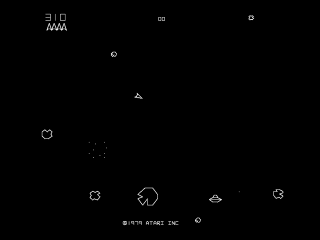Overview
Asteroids was first released as a monochrome, vector-based arcade game by Atari Inc. in November 1979. It was designed and programmed by Dominic Walsh and Ed Logg. The aim of the game is to destroy all of the asteroids that drift randomly across the screen, while also avoiding collision with them. Occasional flying saucers, which come in large and small varieties, attempt to impede progress.
Gameplay
 Original arcade version.
Original arcade version.The objective of Asteroids is to collect as many points as possible by destroying all of the asteroids on screen, and to avoid death (either by collision or being shot by a flying saucer). The ship appears as a small triangle, whose default position is the center of the screen. It can rotate 360 degrees and move forward with the use of thrusters. The ship possesses momentum and will drift for a time after its thrusters are deactivated. At any time, the player may activate a “hyperspace” ability, which warps the ship to a random area of the screen (and possibly into the path of an oncoming asteroid).
The asteroids themselves come in three sizes: large, medium, and small. When large asteroids are shot, they break up into two medium asteroids. The same goes for medium asteroids into small, at which point they can be destroyed with a single shot. In addition to asteroids, there are also two types of flying saucers which appear randomly, accompanied by a siren noise. The large type shoots in random directions, while the small type aims at the player. Destroying a saucer will net the player a 1000 point bonus.
 Atari 2600 version.
Atari 2600 version.The action presented is "wrapped" around the screen along both the horizontal and vertical axis (i.e. if an asteroid drifts off the right side of the screen, it will reappear on the left). The game music consists of a steady “heartbeat” sound which increases in tempo as asteroids are destroyed. After all on-screen asteroids have been eliminated, a new round begins and the number of asteroids increases (up to a maximum of 12). The game ends if the player loses all of his/her lives. Due to a programming bug, the game score will roll back to zero after reaching 99,990.
Development
 Standing arcade cabinet.
Standing arcade cabinet.Asteroids was designed around Atari’s proprietary Digital Vector Generator (DVG), a vector graphics processor that came out of the company’s off-campus research lab in Grass Valley, California. The DVG was first used by Atari engineer Howard Delman to create the company’s first vector-based game, Lunar Lander. When it was decided that Asteroids would also utilize a vector display, Delman modified an existing Lunar Lander board and handed it off to Dominic Walsh and Ed Logg.
The Asteroids board is based around a standard MOS 6502 CPU, which executes the game program, and the aforementioned DVG. Extra memory was added, as well as seven distinct audio circuits. The main Asteroids program uses only 6 KB of ROM code, and another 2 KB of vector ROM contains the descriptions of the main graphical elements (asteroids, saucers, player's ship, explosion pictures, letters, and digits).
Legacy
Asteroids proved to be extremely popular upon its release and, after initially selling over 70,000 units, Atari was forced to ship Asteroids hardware in Lunar Lander cabinets in order to meet the steadily rising demand. In some areas, arcade operators installed larger cash boxes onto their Asteroids cabinets to keep up with the high player traffic. The success of Asteroids prompted Atari to continue iterating on its vector technology; a color display was developed soon after, used in such games as Tempest and Major Havoc.
 Blasteroids, one of several arcade sequels.
Blasteroids, one of several arcade sequels.Asteroids was subsequently ported to most of Atari’s home consoles, including the 2600, 7800 and Lynx. A 5200 version was planned and advertised, but was never actually released. The 7800 version is notable for featuring co-operative play, and was included as a built-in game for the console’s European release. A sequel was released in 1981, dubbed Asteroids Deluxe, that included blue-tinted graphics, a shield ability (in place of a hyperspace jump), rotating asteroids, and new “killer satellite” enemies. Two more arcade sequels followed, with Space Duel arriving in 1982 and Blasteroids in 1987.
Many games have either borrowed some of Asteroids basic mechanics, or cloned its gameplay outright. Included in the former category are Williams’ Sinistar, which has players shoot asteroids in order to collect resources, and Mine Storm, the built-in game for the failed Vectrex system. In the latter group are Acornsoft's Meteors and Ambrosia Software's Maelstrom, as well as Asterax, Astrogeddon, Stardust, Spheres of Chaos and Astro Fire.
In the last few decades, Asteroids has been included in a number of arcade compilations, including the Windows 3.1 Microsoft Arcade packages, Atari Anniversary Edition (2001, Dreamcast and PC), and Atari Anthology (2004, Xbox and Playstation 2). Asteroids (arcade and 2600) and Asteroids Deluxe were also released for Microsoft’s Game Room platform in 2010.
Movie
In July of 2009 it was announced that Universal Studios had won the rights to a movie adaption of the arcade classic Asteroids. Lorenzo di Bonaventura is attached to produce and a script is being penned by Mathew Lopez.
World Record
The world record for the arcade version of Asteroids is 41,338,740 points, set by John McAllister on April 6th, 2010. To achieve the score he played the game for over 58 hours. McAllister's score beat a 27-year-old record of 41,336,440 points previously held by Scott Safran, a 15-year-old boy from Cherry Hill, New Jersey who initially set the record on November 15, 1982.
Log in to comment